Contributory Negligence in Personal Injury
VerifiedAdded on 2020/05/28
|11
|1908
|57
AI Summary
The assignment examines a personal injury case involving Tamara, who was partially responsible for her own injury while running to purchase the last piece of chocolate. It explores the principle of contributory negligence, explaining that if proven, it reduces the plaintiff's ability to recover full damages. The case study uses the Sorrells v M.Y.B. Hospitality Ventures ruling as an example and analyzes how Tamara's actions could be used as a defense against her claim.
Contribute Materials
Your contribution can guide someone’s learning journey. Share your
documents today.
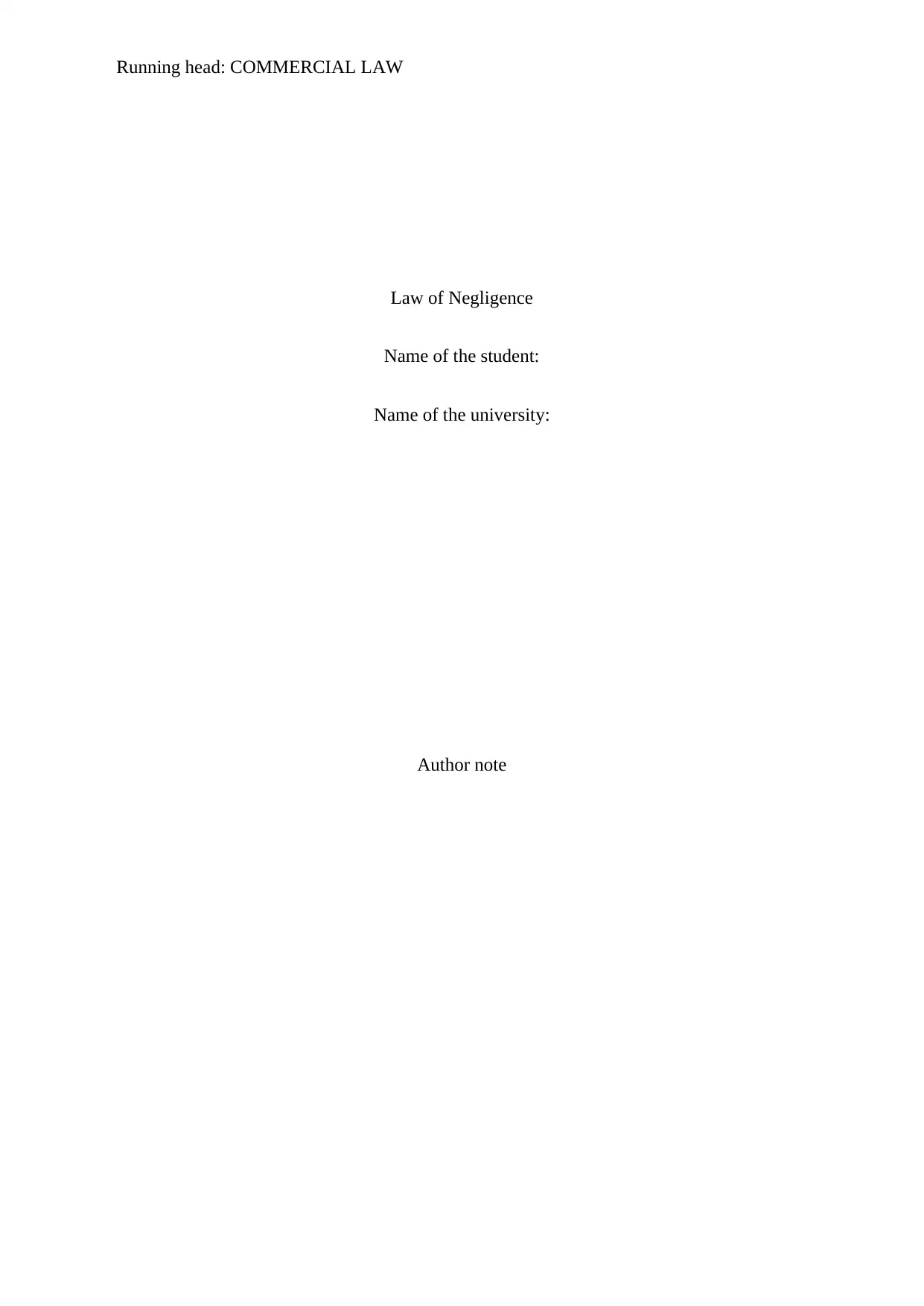
Running head: COMMERCIAL LAW
Law of Negligence
Name of the student:
Name of the university:
Author note
Law of Negligence
Name of the student:
Name of the university:
Author note
Secure Best Marks with AI Grader
Need help grading? Try our AI Grader for instant feedback on your assignments.
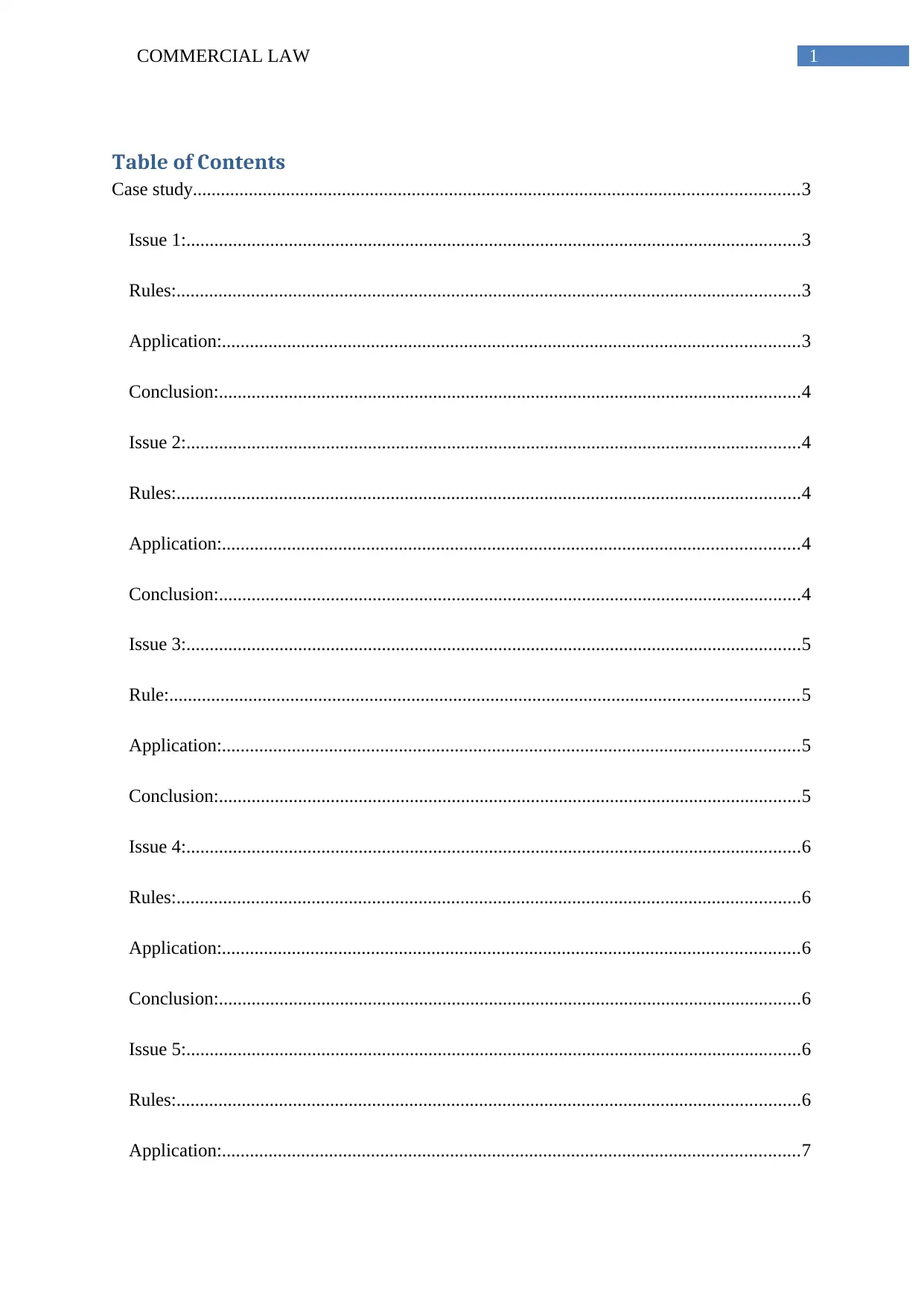
1COMMERCIAL LAW
Table of Contents
Case study..................................................................................................................................3
Issue 1:....................................................................................................................................3
Rules:......................................................................................................................................3
Application:............................................................................................................................3
Conclusion:.............................................................................................................................4
Issue 2:....................................................................................................................................4
Rules:......................................................................................................................................4
Application:............................................................................................................................4
Conclusion:.............................................................................................................................4
Issue 3:....................................................................................................................................5
Rule:.......................................................................................................................................5
Application:............................................................................................................................5
Conclusion:.............................................................................................................................5
Issue 4:....................................................................................................................................6
Rules:......................................................................................................................................6
Application:............................................................................................................................6
Conclusion:.............................................................................................................................6
Issue 5:....................................................................................................................................6
Rules:......................................................................................................................................6
Application:............................................................................................................................7
Table of Contents
Case study..................................................................................................................................3
Issue 1:....................................................................................................................................3
Rules:......................................................................................................................................3
Application:............................................................................................................................3
Conclusion:.............................................................................................................................4
Issue 2:....................................................................................................................................4
Rules:......................................................................................................................................4
Application:............................................................................................................................4
Conclusion:.............................................................................................................................4
Issue 3:....................................................................................................................................5
Rule:.......................................................................................................................................5
Application:............................................................................................................................5
Conclusion:.............................................................................................................................5
Issue 4:....................................................................................................................................6
Rules:......................................................................................................................................6
Application:............................................................................................................................6
Conclusion:.............................................................................................................................6
Issue 5:....................................................................................................................................6
Rules:......................................................................................................................................6
Application:............................................................................................................................7
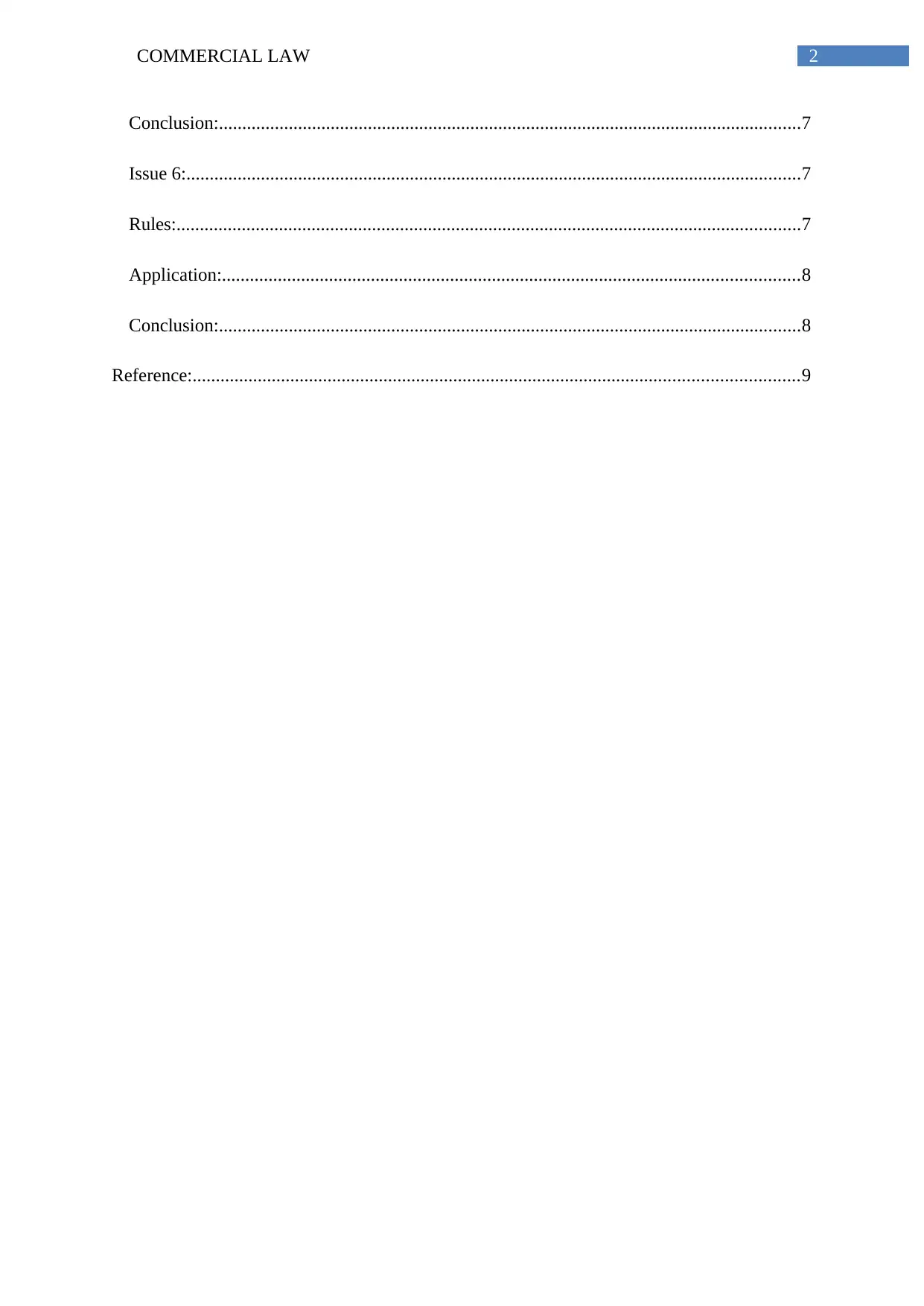
2COMMERCIAL LAW
Conclusion:.............................................................................................................................7
Issue 6:....................................................................................................................................7
Rules:......................................................................................................................................7
Application:............................................................................................................................8
Conclusion:.............................................................................................................................8
Reference:..................................................................................................................................9
Conclusion:.............................................................................................................................7
Issue 6:....................................................................................................................................7
Rules:......................................................................................................................................7
Application:............................................................................................................................8
Conclusion:.............................................................................................................................8
Reference:..................................................................................................................................9
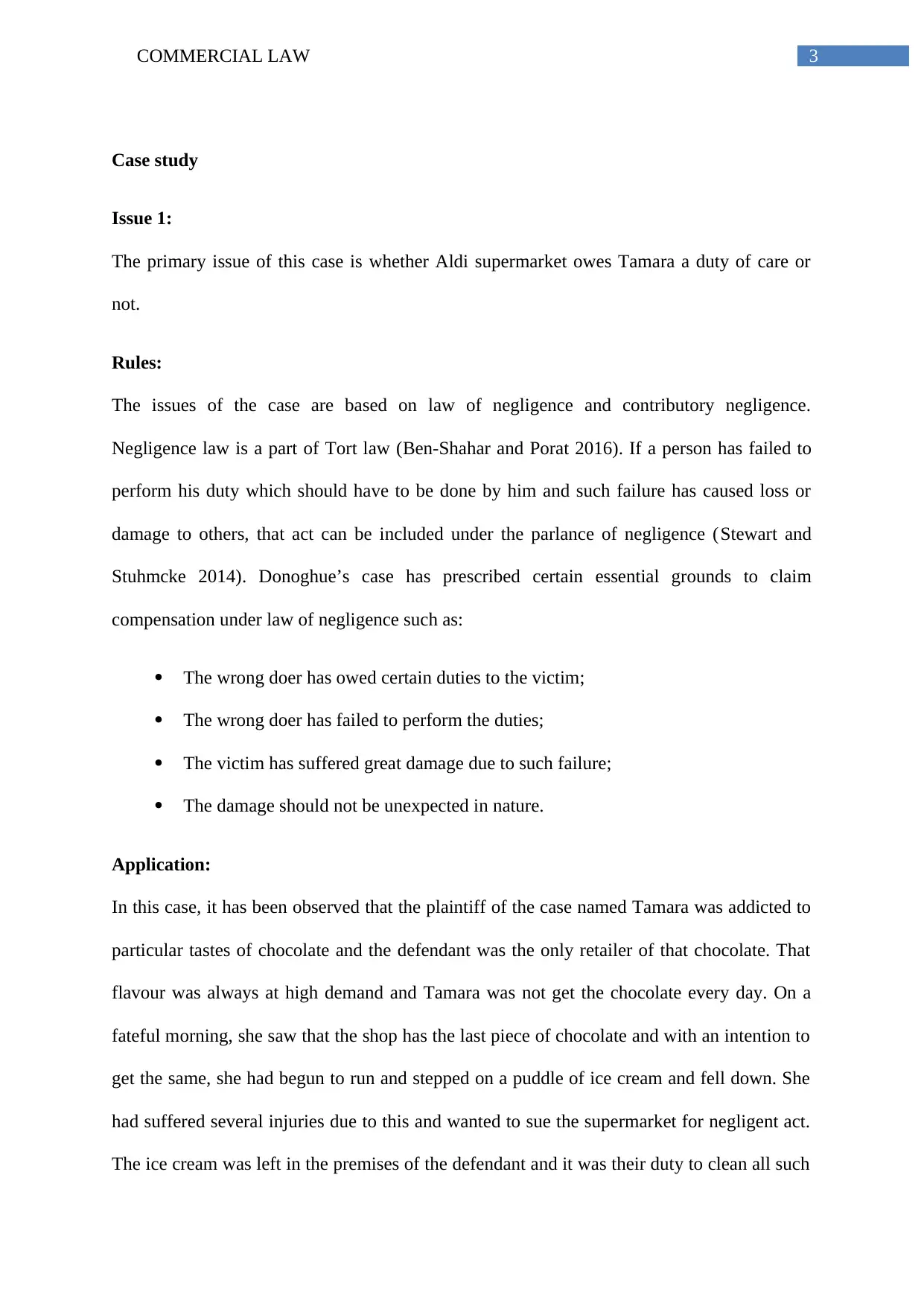
3COMMERCIAL LAW
Case study
Issue 1:
The primary issue of this case is whether Aldi supermarket owes Tamara a duty of care or
not.
Rules:
The issues of the case are based on law of negligence and contributory negligence.
Negligence law is a part of Tort law (Ben-Shahar and Porat 2016). If a person has failed to
perform his duty which should have to be done by him and such failure has caused loss or
damage to others, that act can be included under the parlance of negligence (Stewart and
Stuhmcke 2014). Donoghue’s case has prescribed certain essential grounds to claim
compensation under law of negligence such as:
The wrong doer has owed certain duties to the victim;
The wrong doer has failed to perform the duties;
The victim has suffered great damage due to such failure;
The damage should not be unexpected in nature.
Application:
In this case, it has been observed that the plaintiff of the case named Tamara was addicted to
particular tastes of chocolate and the defendant was the only retailer of that chocolate. That
flavour was always at high demand and Tamara was not get the chocolate every day. On a
fateful morning, she saw that the shop has the last piece of chocolate and with an intention to
get the same, she had begun to run and stepped on a puddle of ice cream and fell down. She
had suffered several injuries due to this and wanted to sue the supermarket for negligent act.
The ice cream was left in the premises of the defendant and it was their duty to clean all such
Case study
Issue 1:
The primary issue of this case is whether Aldi supermarket owes Tamara a duty of care or
not.
Rules:
The issues of the case are based on law of negligence and contributory negligence.
Negligence law is a part of Tort law (Ben-Shahar and Porat 2016). If a person has failed to
perform his duty which should have to be done by him and such failure has caused loss or
damage to others, that act can be included under the parlance of negligence (Stewart and
Stuhmcke 2014). Donoghue’s case has prescribed certain essential grounds to claim
compensation under law of negligence such as:
The wrong doer has owed certain duties to the victim;
The wrong doer has failed to perform the duties;
The victim has suffered great damage due to such failure;
The damage should not be unexpected in nature.
Application:
In this case, it has been observed that the plaintiff of the case named Tamara was addicted to
particular tastes of chocolate and the defendant was the only retailer of that chocolate. That
flavour was always at high demand and Tamara was not get the chocolate every day. On a
fateful morning, she saw that the shop has the last piece of chocolate and with an intention to
get the same, she had begun to run and stepped on a puddle of ice cream and fell down. She
had suffered several injuries due to this and wanted to sue the supermarket for negligent act.
The ice cream was left in the premises of the defendant and it was their duty to clean all such
Secure Best Marks with AI Grader
Need help grading? Try our AI Grader for instant feedback on your assignments.
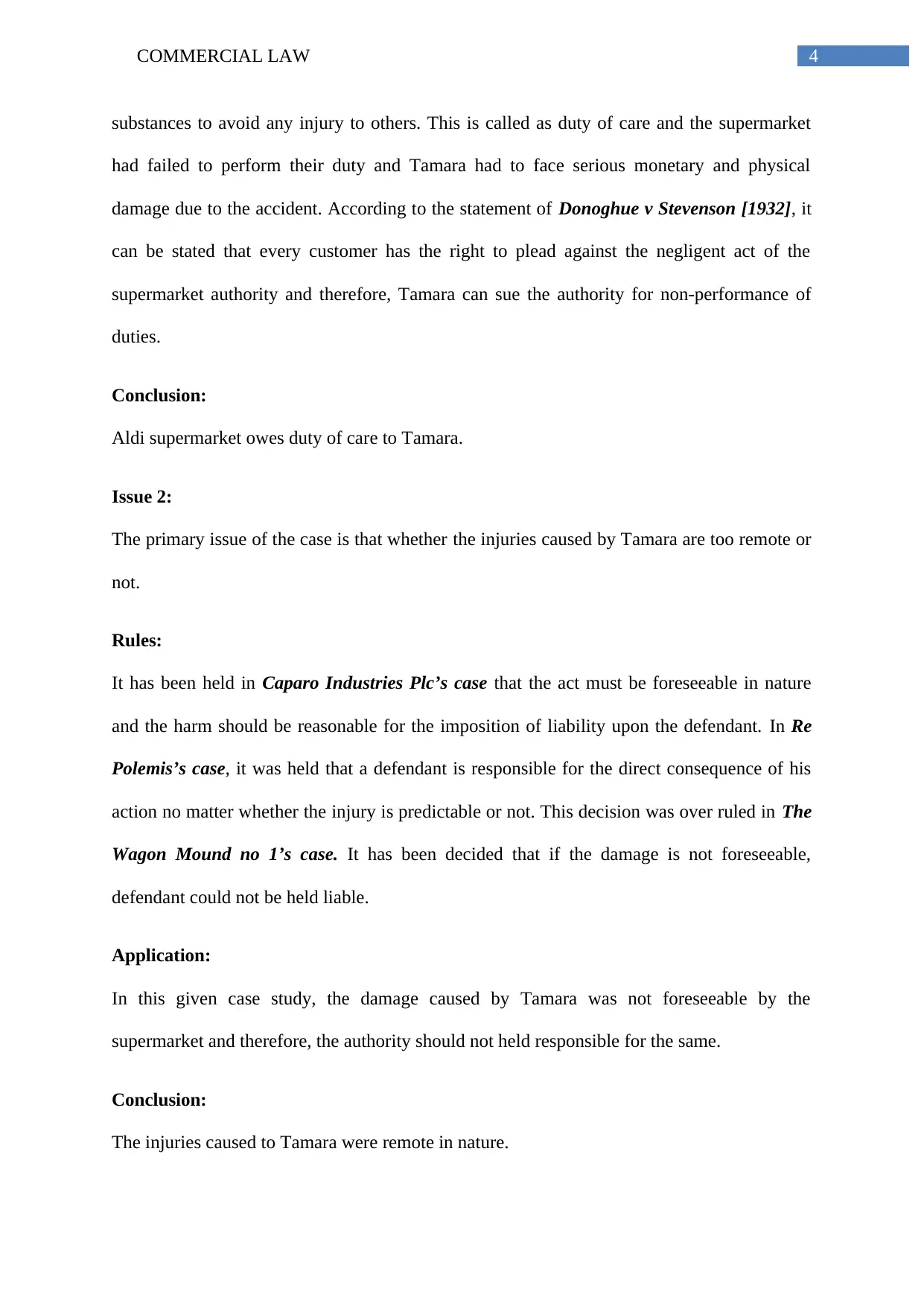
4COMMERCIAL LAW
substances to avoid any injury to others. This is called as duty of care and the supermarket
had failed to perform their duty and Tamara had to face serious monetary and physical
damage due to the accident. According to the statement of Donoghue v Stevenson [1932], it
can be stated that every customer has the right to plead against the negligent act of the
supermarket authority and therefore, Tamara can sue the authority for non-performance of
duties.
Conclusion:
Aldi supermarket owes duty of care to Tamara.
Issue 2:
The primary issue of the case is that whether the injuries caused by Tamara are too remote or
not.
Rules:
It has been held in Caparo Industries Plc’s case that the act must be foreseeable in nature
and the harm should be reasonable for the imposition of liability upon the defendant. In Re
Polemis’s case, it was held that a defendant is responsible for the direct consequence of his
action no matter whether the injury is predictable or not. This decision was over ruled in The
Wagon Mound no 1’s case. It has been decided that if the damage is not foreseeable,
defendant could not be held liable.
Application:
In this given case study, the damage caused by Tamara was not foreseeable by the
supermarket and therefore, the authority should not held responsible for the same.
Conclusion:
The injuries caused to Tamara were remote in nature.
substances to avoid any injury to others. This is called as duty of care and the supermarket
had failed to perform their duty and Tamara had to face serious monetary and physical
damage due to the accident. According to the statement of Donoghue v Stevenson [1932], it
can be stated that every customer has the right to plead against the negligent act of the
supermarket authority and therefore, Tamara can sue the authority for non-performance of
duties.
Conclusion:
Aldi supermarket owes duty of care to Tamara.
Issue 2:
The primary issue of the case is that whether the injuries caused by Tamara are too remote or
not.
Rules:
It has been held in Caparo Industries Plc’s case that the act must be foreseeable in nature
and the harm should be reasonable for the imposition of liability upon the defendant. In Re
Polemis’s case, it was held that a defendant is responsible for the direct consequence of his
action no matter whether the injury is predictable or not. This decision was over ruled in The
Wagon Mound no 1’s case. It has been decided that if the damage is not foreseeable,
defendant could not be held liable.
Application:
In this given case study, the damage caused by Tamara was not foreseeable by the
supermarket and therefore, the authority should not held responsible for the same.
Conclusion:
The injuries caused to Tamara were remote in nature.
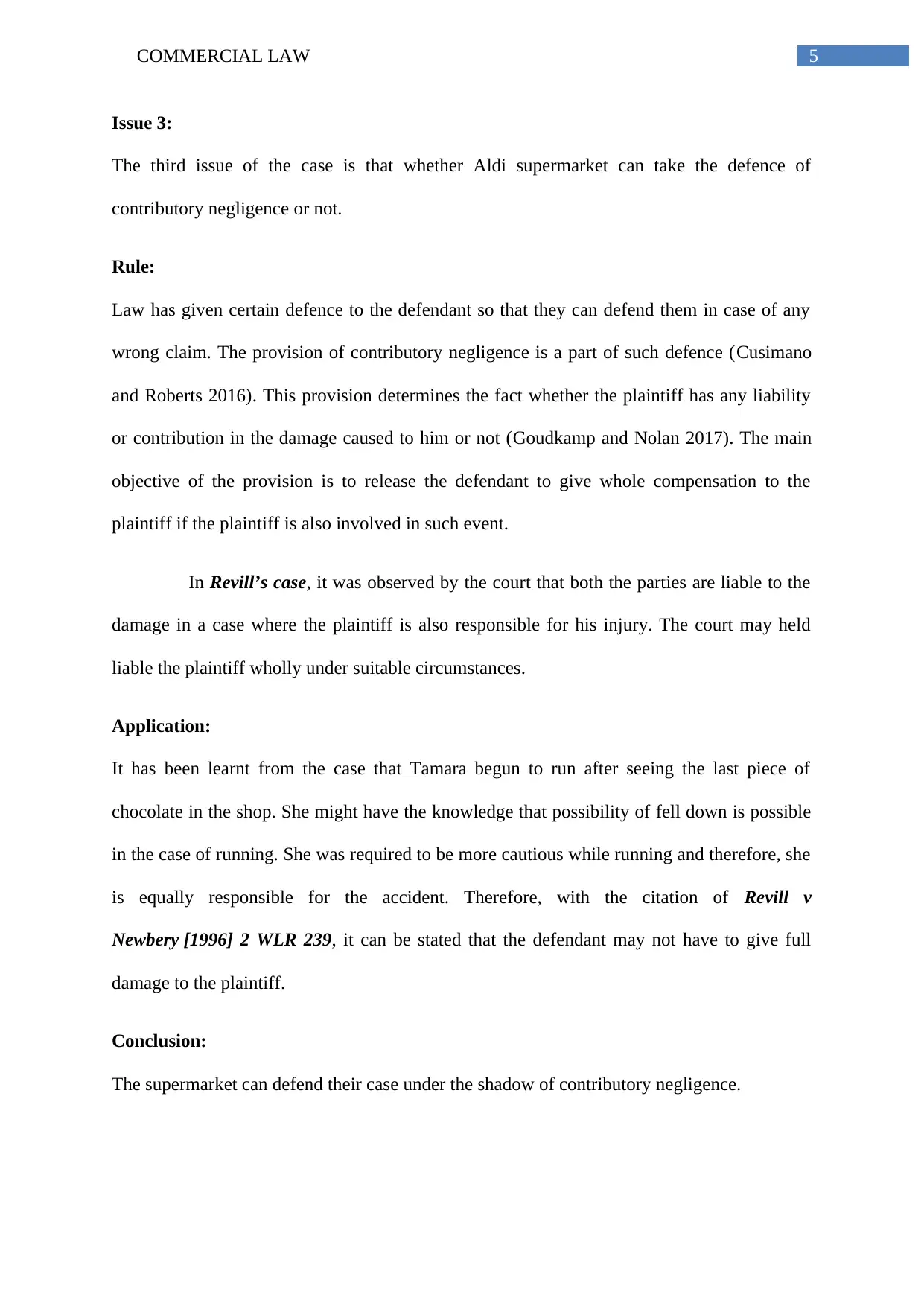
5COMMERCIAL LAW
Issue 3:
The third issue of the case is that whether Aldi supermarket can take the defence of
contributory negligence or not.
Rule:
Law has given certain defence to the defendant so that they can defend them in case of any
wrong claim. The provision of contributory negligence is a part of such defence (Cusimano
and Roberts 2016). This provision determines the fact whether the plaintiff has any liability
or contribution in the damage caused to him or not (Goudkamp and Nolan 2017). The main
objective of the provision is to release the defendant to give whole compensation to the
plaintiff if the plaintiff is also involved in such event.
In Revill’s case, it was observed by the court that both the parties are liable to the
damage in a case where the plaintiff is also responsible for his injury. The court may held
liable the plaintiff wholly under suitable circumstances.
Application:
It has been learnt from the case that Tamara begun to run after seeing the last piece of
chocolate in the shop. She might have the knowledge that possibility of fell down is possible
in the case of running. She was required to be more cautious while running and therefore, she
is equally responsible for the accident. Therefore, with the citation of Revill v
Newbery [1996] 2 WLR 239, it can be stated that the defendant may not have to give full
damage to the plaintiff.
Conclusion:
The supermarket can defend their case under the shadow of contributory negligence.
Issue 3:
The third issue of the case is that whether Aldi supermarket can take the defence of
contributory negligence or not.
Rule:
Law has given certain defence to the defendant so that they can defend them in case of any
wrong claim. The provision of contributory negligence is a part of such defence (Cusimano
and Roberts 2016). This provision determines the fact whether the plaintiff has any liability
or contribution in the damage caused to him or not (Goudkamp and Nolan 2017). The main
objective of the provision is to release the defendant to give whole compensation to the
plaintiff if the plaintiff is also involved in such event.
In Revill’s case, it was observed by the court that both the parties are liable to the
damage in a case where the plaintiff is also responsible for his injury. The court may held
liable the plaintiff wholly under suitable circumstances.
Application:
It has been learnt from the case that Tamara begun to run after seeing the last piece of
chocolate in the shop. She might have the knowledge that possibility of fell down is possible
in the case of running. She was required to be more cautious while running and therefore, she
is equally responsible for the accident. Therefore, with the citation of Revill v
Newbery [1996] 2 WLR 239, it can be stated that the defendant may not have to give full
damage to the plaintiff.
Conclusion:
The supermarket can defend their case under the shadow of contributory negligence.
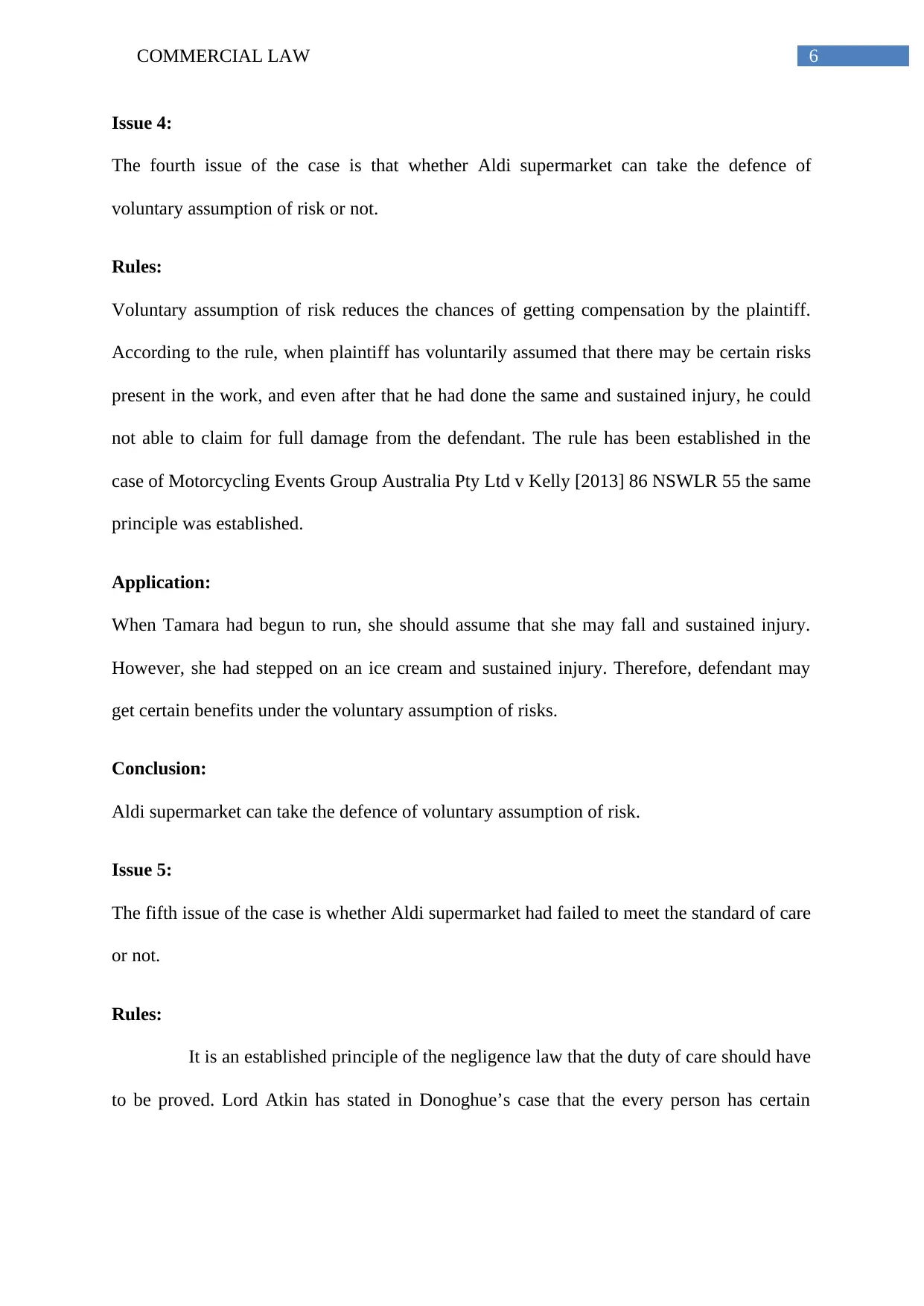
6COMMERCIAL LAW
Issue 4:
The fourth issue of the case is that whether Aldi supermarket can take the defence of
voluntary assumption of risk or not.
Rules:
Voluntary assumption of risk reduces the chances of getting compensation by the plaintiff.
According to the rule, when plaintiff has voluntarily assumed that there may be certain risks
present in the work, and even after that he had done the same and sustained injury, he could
not able to claim for full damage from the defendant. The rule has been established in the
case of Motorcycling Events Group Australia Pty Ltd v Kelly [2013] 86 NSWLR 55 the same
principle was established.
Application:
When Tamara had begun to run, she should assume that she may fall and sustained injury.
However, she had stepped on an ice cream and sustained injury. Therefore, defendant may
get certain benefits under the voluntary assumption of risks.
Conclusion:
Aldi supermarket can take the defence of voluntary assumption of risk.
Issue 5:
The fifth issue of the case is whether Aldi supermarket had failed to meet the standard of care
or not.
Rules:
It is an established principle of the negligence law that the duty of care should have
to be proved. Lord Atkin has stated in Donoghue’s case that the every person has certain
Issue 4:
The fourth issue of the case is that whether Aldi supermarket can take the defence of
voluntary assumption of risk or not.
Rules:
Voluntary assumption of risk reduces the chances of getting compensation by the plaintiff.
According to the rule, when plaintiff has voluntarily assumed that there may be certain risks
present in the work, and even after that he had done the same and sustained injury, he could
not able to claim for full damage from the defendant. The rule has been established in the
case of Motorcycling Events Group Australia Pty Ltd v Kelly [2013] 86 NSWLR 55 the same
principle was established.
Application:
When Tamara had begun to run, she should assume that she may fall and sustained injury.
However, she had stepped on an ice cream and sustained injury. Therefore, defendant may
get certain benefits under the voluntary assumption of risks.
Conclusion:
Aldi supermarket can take the defence of voluntary assumption of risk.
Issue 5:
The fifth issue of the case is whether Aldi supermarket had failed to meet the standard of care
or not.
Rules:
It is an established principle of the negligence law that the duty of care should have
to be proved. Lord Atkin has stated in Donoghue’s case that the every person has certain
Paraphrase This Document
Need a fresh take? Get an instant paraphrase of this document with our AI Paraphraser

7COMMERCIAL LAW
reciprocal duties to each other and must see that any other person may not get affected by his
acts.
In Sullivan’s case, it was held that defendant has no right to cause damage to
others and such mandate should have to be maintained in all situations.
In Perre’s case, it has been stated that the relationship between the plaintiff and
defendant should be defined as proximate relation and it has been held that each party owe
certain duties to each other that should have to be performed. The relation in between
shopkeeper and customer or neighbours can be defined as proximate relationship. Proximate
causes are defining the responsibility of defendant.
Application:
It is the duty of the supermarket to keep their premises clean so that no injury can be caused
to the customer. However, Aldi had failed to maintain its premises and Tamara got injured
due to this.
Conclusion:
Aldi had failed to perform its standard duty of care.
Issue 6:
The last issue of the case is whether Tamara will be able to recover full value of her losses or
not.
Rules:
It is a well established principle of law that if the principle of contributory
negligence can be proved, the plaintiff could not recover full amount of damage from the
defendant as plaintiff is equally liable for the damage caused to him. In Sorrells v M.Y.B.
Hospitality Ventures 332 N.C. 645 (1992), it was held that the plaintiff will not be able to
reciprocal duties to each other and must see that any other person may not get affected by his
acts.
In Sullivan’s case, it was held that defendant has no right to cause damage to
others and such mandate should have to be maintained in all situations.
In Perre’s case, it has been stated that the relationship between the plaintiff and
defendant should be defined as proximate relation and it has been held that each party owe
certain duties to each other that should have to be performed. The relation in between
shopkeeper and customer or neighbours can be defined as proximate relationship. Proximate
causes are defining the responsibility of defendant.
Application:
It is the duty of the supermarket to keep their premises clean so that no injury can be caused
to the customer. However, Aldi had failed to maintain its premises and Tamara got injured
due to this.
Conclusion:
Aldi had failed to perform its standard duty of care.
Issue 6:
The last issue of the case is whether Tamara will be able to recover full value of her losses or
not.
Rules:
It is a well established principle of law that if the principle of contributory
negligence can be proved, the plaintiff could not recover full amount of damage from the
defendant as plaintiff is equally liable for the damage caused to him. In Sorrells v M.Y.B.
Hospitality Ventures 332 N.C. 645 (1992), it was held that the plaintiff will not be able to
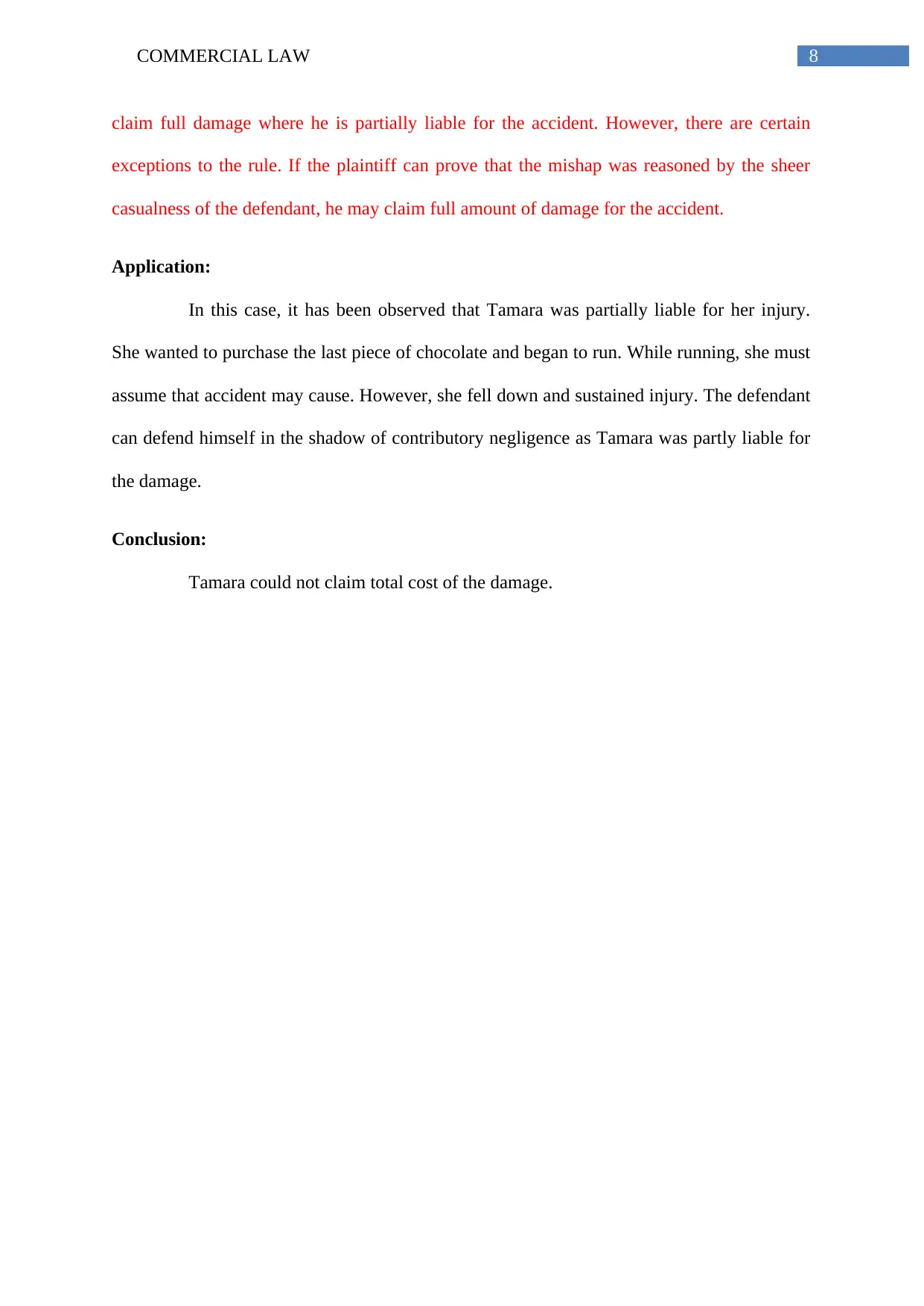
8COMMERCIAL LAW
claim full damage where he is partially liable for the accident. However, there are certain
exceptions to the rule. If the plaintiff can prove that the mishap was reasoned by the sheer
casualness of the defendant, he may claim full amount of damage for the accident.
Application:
In this case, it has been observed that Tamara was partially liable for her injury.
She wanted to purchase the last piece of chocolate and began to run. While running, she must
assume that accident may cause. However, she fell down and sustained injury. The defendant
can defend himself in the shadow of contributory negligence as Tamara was partly liable for
the damage.
Conclusion:
Tamara could not claim total cost of the damage.
claim full damage where he is partially liable for the accident. However, there are certain
exceptions to the rule. If the plaintiff can prove that the mishap was reasoned by the sheer
casualness of the defendant, he may claim full amount of damage for the accident.
Application:
In this case, it has been observed that Tamara was partially liable for her injury.
She wanted to purchase the last piece of chocolate and began to run. While running, she must
assume that accident may cause. However, she fell down and sustained injury. The defendant
can defend himself in the shadow of contributory negligence as Tamara was partly liable for
the damage.
Conclusion:
Tamara could not claim total cost of the damage.

9COMMERCIAL LAW
Reference:
Barry, C., 2017. Statutory modifications of contributory negligence at common
law. Precedent (Sydney, NSW), (140), p.12.
Ben-Shahar, O. and Porat, A., 2016. Personalizing Negligence Law. NYUL Rev., 91, p.627.
Caparo Industries Plc v Dickman [1990] UKHL 2
Cusimano, G.S. and Roberts, M.L., 2016. Contributory Negligence and Assumption of
Risk. Alabama Tort Law, 1.
Donoghue v Stevenson [1932] AC 562
Foley, M. and Christensen, M., 2016. Negligence and the Duty of Care: A Case Study
Discussion. Singapore Nursing Journal, 43(1).
Goudkamp, J. and Nolan, D., 2017. Contributory negligence on appeal.
Grant v Australian Knitting Mills (AKR) (1936) A.C. 85
Humphrey, C. and Chiarella, M., 2015. Legal frameworks for practice in Australia and New
Zealand. Midwifery-E-Book: Preparation for Practice, p.304.
Maguire, R.L. and Banks, A., 2015. The risk of negligence following the failure of a human
replacement function in an automated system.
Perre v Apand Pty Ltd [1999] HCA 36
Pitts v Hunt [1990] 3 All ER 344
Re Polemis & Furness Withy & Company ltd. [1921]3 KB 560
Revill v Newbery [1996] 2 WLR 239
Reference:
Barry, C., 2017. Statutory modifications of contributory negligence at common
law. Precedent (Sydney, NSW), (140), p.12.
Ben-Shahar, O. and Porat, A., 2016. Personalizing Negligence Law. NYUL Rev., 91, p.627.
Caparo Industries Plc v Dickman [1990] UKHL 2
Cusimano, G.S. and Roberts, M.L., 2016. Contributory Negligence and Assumption of
Risk. Alabama Tort Law, 1.
Donoghue v Stevenson [1932] AC 562
Foley, M. and Christensen, M., 2016. Negligence and the Duty of Care: A Case Study
Discussion. Singapore Nursing Journal, 43(1).
Goudkamp, J. and Nolan, D., 2017. Contributory negligence on appeal.
Grant v Australian Knitting Mills (AKR) (1936) A.C. 85
Humphrey, C. and Chiarella, M., 2015. Legal frameworks for practice in Australia and New
Zealand. Midwifery-E-Book: Preparation for Practice, p.304.
Maguire, R.L. and Banks, A., 2015. The risk of negligence following the failure of a human
replacement function in an automated system.
Perre v Apand Pty Ltd [1999] HCA 36
Pitts v Hunt [1990] 3 All ER 344
Re Polemis & Furness Withy & Company ltd. [1921]3 KB 560
Revill v Newbery [1996] 2 WLR 239
Secure Best Marks with AI Grader
Need help grading? Try our AI Grader for instant feedback on your assignments.
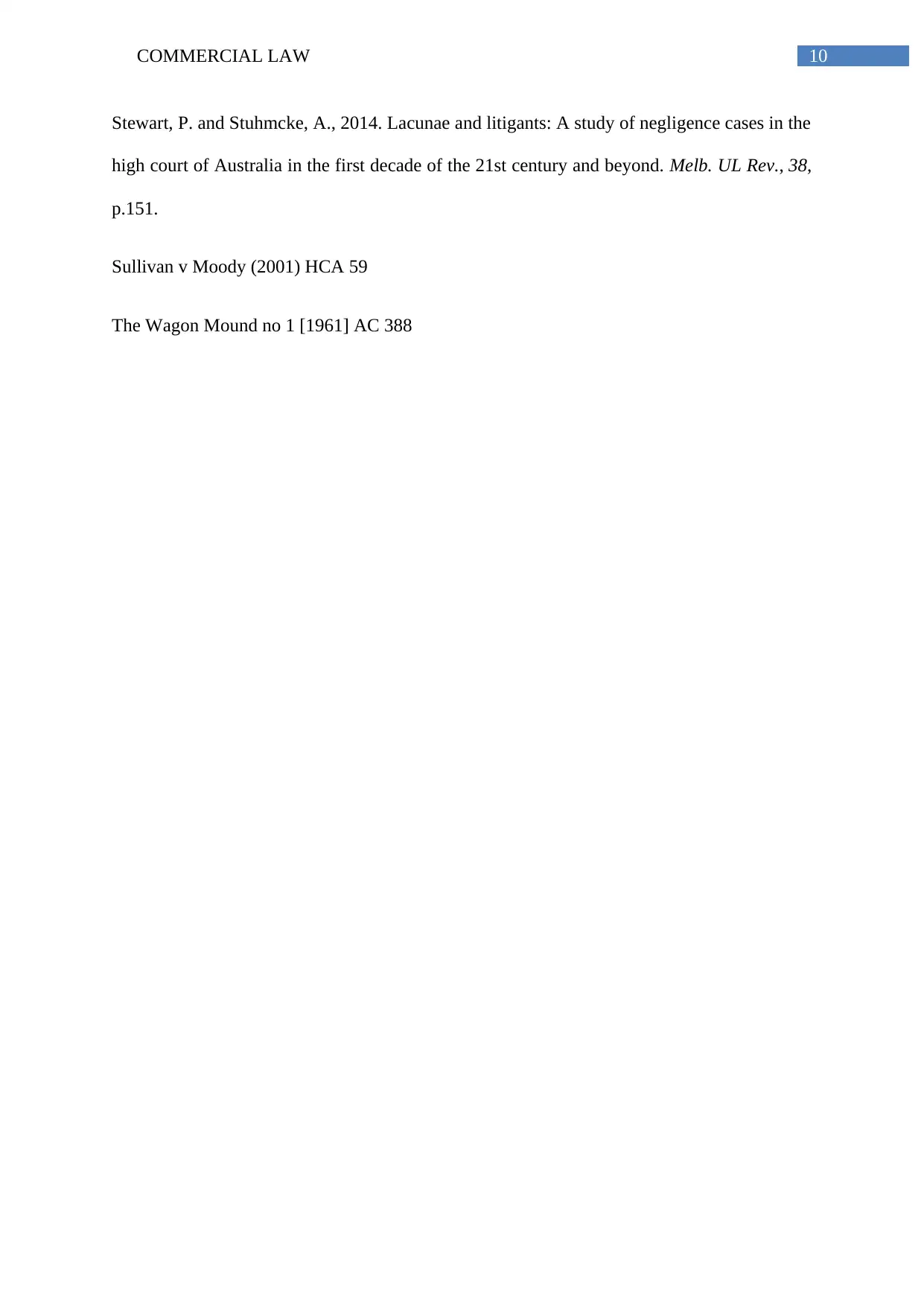
10COMMERCIAL LAW
Stewart, P. and Stuhmcke, A., 2014. Lacunae and litigants: A study of negligence cases in the
high court of Australia in the first decade of the 21st century and beyond. Melb. UL Rev., 38,
p.151.
Sullivan v Moody (2001) HCA 59
The Wagon Mound no 1 [1961] AC 388
Stewart, P. and Stuhmcke, A., 2014. Lacunae and litigants: A study of negligence cases in the
high court of Australia in the first decade of the 21st century and beyond. Melb. UL Rev., 38,
p.151.
Sullivan v Moody (2001) HCA 59
The Wagon Mound no 1 [1961] AC 388
1 out of 11
Related Documents
Your All-in-One AI-Powered Toolkit for Academic Success.
+13062052269
info@desklib.com
Available 24*7 on WhatsApp / Email
![[object Object]](/_next/static/media/star-bottom.7253800d.svg)
Unlock your academic potential
© 2024 | Zucol Services PVT LTD | All rights reserved.




